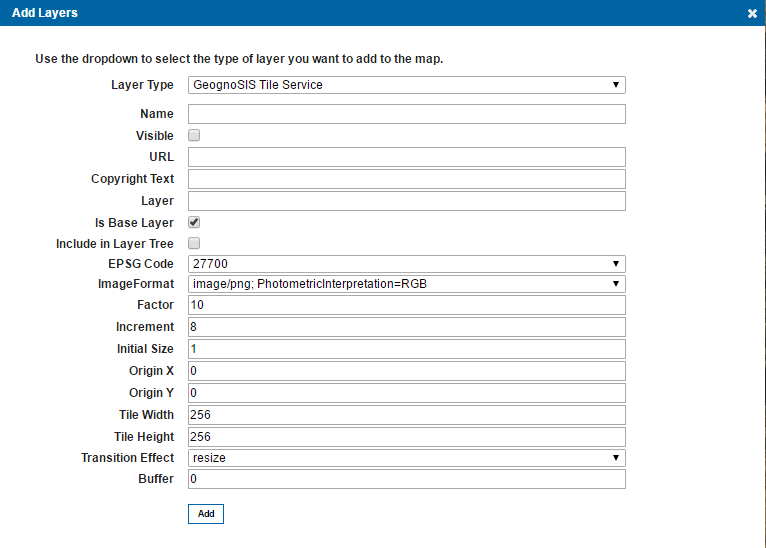GeognoSIS Tile Service
A GeognoSIS Tile Service is a Cadcorp Tile Cache that is served out by GeognoSIS. The first time tiles are loaded a request will be sent to Cadcorp GeognoSIS and the tiles will be created. These created tiles will also be cached and stored in the TileCache folder of the GeognoSIS installation folder (e.g. C:\Program Files\Cadcorp GeognoSIS 8.0\TileCache). From then onwards any other users who want to view the same tiles will view the cached tiles directly, rather than creating new requests to Cadcorp GeognoSIS. The more users that pan around the map the bigger the tile cache will become.
You can build a Cadcorp Tile Cache using the Cadcorp Tile Cache Builder application.
The following parameters are required for adding a GeognoSIS Tile Service:

| Field | Is it Optional or Required? |
Description |
| Name | Required | An appropriate user added name. The name that will be displayed for the layer. |
| Visible | Required | Check this tickbox to define the layer as visible. |
| URL | Required | The URL connection to the Cadcorp GeognoSIS instance, for example http://server.domain:4326/tileservice/tile.exe. |
| Copyright Text | Optional | Text entered here will appear across the bottom left of your Web Map Layers 8.0 site. |
| Layer | Required | The name of the Layer you want to add from the Tile Service. |
| Is Base Layer | Required | Checking this box defines the layer to be added as a Base Layer. |
| Include in Layer Tree | Optional | If the data is being served out as a base layer and the site will be accessed on a mobile device, this option allows you to switch between base layers in the Map Features dialog. (The base layer selector on the top right of the site is not included in the mobile version of Web Map Layers 8.0). |
| EPSG Code | Required | The EPSG code that the tile cache was created in. |
| Image Format | Required | Select from the drop down list the image format that the tile cache was created in. |
| Factor | Required | The multiplier value applied to the initial value to define the levels, according the increment value. |
| Increment | Required | Combined with the factor and the initial size defines the levels. |
| Initial Size | Required | Helps define the highest resolution. This value is in CRS units (i.e. for OSGB it is metres and for WGS84 it is degrees). |
| Origin X | Required | The x coordinate of the origin (as defined when the tile cache was built). |
| Origin Y | Required | The y coordinate of the origin (as defined when the tile cache was built). |
| Tile Width | Required | The width of the tiles to be displayed (as defined when the cache was built). |
| Tile Height | Required | The height of the tiles to be displayed (as defined when the cache was built). |
| Transition Effect | Required | This is set by default to Resize, this means that when the map is zoomed, the tile is resized to give the effect that the zoom has taken place immediately, the actual tile is then drawn on top of the resized one as it becomes available. |
| Buffer | Required | This is the number of extra tiles to load around the map that is displayed on the screen. Having a buffer makes panning smoother but a large buffer will result in a slower map render as it will take longer for all the tile requests to be returned by GeognoSIS. |
Further Details on Initial Size, Increment and Factor
The initial size helps define the resolution the data will be displayed at, at level 0. In this example it is 1m. Larger values can be selected for the initial size, but this will reduce the highest resolution available.
The resolution of subsequent levels is determined by the factor and increment, see the diagram below. For every increment increase the resolution is multiplied by the factor.

Send comments on this topic.